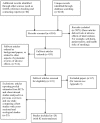Comparison of pooled risk estimates for adverse effects from different observational study designs: methodological overview
- PMID: 23977151
- PMCID: PMC3748094
- DOI: 10.1371/journal.pone.0071813
Comparison of pooled risk estimates for adverse effects from different observational study designs: methodological overview
Abstract
Background: A diverse range of study designs (e.g. case-control or cohort) are used in the evaluation of adverse effects. We aimed to ascertain whether the risk estimates from meta-analyses of case-control studies differ from that of other study designs.
Methods: Searches were carried out in 10 databases in addition to reference checking, contacting experts, and handsearching key journals and conference proceedings. Studies were included where a pooled relative measure of an adverse effect (odds ratio or risk ratio) from case-control studies could be directly compared with the pooled estimate for the same adverse effect arising from other types of observational studies.
Results: We included 82 meta-analyses. Pooled estimates of harm from the different study designs had 95% confidence intervals that overlapped in 78/82 instances (95%). Of the 23 cases of discrepant findings (significant harm identified in meta-analysis of one type of study design, but not with the other study design), 16 (70%) stemmed from significantly elevated pooled estimates from case-control studies. There was associated evidence of funnel plot asymmetry consistent with higher risk estimates from case-control studies. On average, cohort or cross-sectional studies yielded pooled odds ratios 0.94 (95% CI 0.88-1.00) times lower than that from case-control studies.
Interpretation: Empirical evidence from this overview indicates that meta-analysis of case-control studies tend to give slightly higher estimates of harm as compared to meta-analyses of other observational studies. However it is impossible to rule out potential confounding from differences in drug dose, duration and populations when comparing between study designs.
Conflict of interest statement
Figures
Similar articles
-
Meta-analyses of adverse effects data derived from randomised controlled trials as compared to observational studies: methodological overview.PLoS Med. 2011 May;8(5):e1001026. doi: 10.1371/journal.pmed.1001026. Epub 2011 May 3. PLoS Med. 2011. PMID: 21559325 Free PMC article. Review.
-
Deployment of personnel to military operations: impact on mental health and social functioning.Campbell Syst Rev. 2018 Jun 1;14(1):1-127. doi: 10.4073/csr.2018.6. eCollection 2018. Campbell Syst Rev. 2018. PMID: 37131363 Free PMC article.
-
Small class sizes for improving student achievement in primary and secondary schools: a systematic review.Campbell Syst Rev. 2018 Oct 11;14(1):1-107. doi: 10.4073/csr.2018.10. eCollection 2018. Campbell Syst Rev. 2018. PMID: 37131395 Free PMC article.
-
The association between periodontal disease and the risk of myocardial infarction: a pooled analysis of observational studies.BMC Cardiovasc Disord. 2017 Feb 1;17(1):50. doi: 10.1186/s12872-017-0480-y. BMC Cardiovasc Disord. 2017. PMID: 28143450 Free PMC article. Review.
-
Reducing unemployment benefit duration to increase job finding rates: a systematic review.Campbell Syst Rev. 2018 Feb 28;14(1):1-194. doi: 10.4073/csr.2018.2. eCollection 2018. Campbell Syst Rev. 2018. PMID: 37131392 Free PMC article.
Cited by
-
The relevance of the real-world evidence in research, clinical, and regulatory decision making.Front Public Health. 2025 Feb 18;13:1512429. doi: 10.3389/fpubh.2025.1512429. eCollection 2025. Front Public Health. 2025. PMID: 40041193 Free PMC article. Review.
-
What Is the Plural of a 'Yellow' Anecdote?Drug Saf. 2016 Jan;39(1):1-3. doi: 10.1007/s40264-015-0368-7. Drug Saf. 2016. PMID: 26597283 No abstract available.
-
Comparison of Estimates between Cohort and Case-Control Studies in Meta-Analyses of Therapeutic Interventions: A Meta-Epidemiological Study.PLoS One. 2016 May 9;11(5):e0154877. doi: 10.1371/journal.pone.0154877. eCollection 2016. PLoS One. 2016. PMID: 27159025 Free PMC article.
-
Variation in adverse drug reactions listed in product information for antidepressants and anticonvulsants, between the USA and Europe: a comparison review of paired regulatory documents.BMJ Open. 2016 Mar 20;6(3):e010599. doi: 10.1136/bmjopen-2015-010599. BMJ Open. 2016. PMID: 26996819 Free PMC article.
-
Risk of Dementia in Long-Term Benzodiazepine Users: Evidence from a Meta-Analysis of Observational Studies.J Clin Neurol. 2019 Jan;15(1):9-19. doi: 10.3988/jcn.2019.15.1.9. Epub 2018 Oct 26. J Clin Neurol. 2019. PMID: 30375757 Free PMC article.
References
Publication types
MeSH terms
Substances
LinkOut - more resources
Full Text Sources
Other Literature Sources



